Содержание
- 2. The building blocks of theories (1) What (constructs/variables) How (causal relationships) Why (theoretical explanations) Hows +
- 3. The building blocks of theories (2) Construct (or concept): an abstract, unobservable property or attribute of
- 4. TURBAN ET AL. PAPER
- 5. Many scholars and practitioners today are paying increasing attention to firms' corporate social performance (CSP), a
- 6. Attracting and retaining superior human resources can provide organizations with a sustained competitive advantage (Lado &
- 7. Turban et al.: knowledge gap… Additionally, scholars have suggested that firms adopting socially responsible actions may
- 8. Turban et al.: hypotheses to fill the gap Hypothesis 1. Organizations higher on independently rated corporate
- 9. Propositions based on signaling theory suggest that organizational attributes provide applicants with information about what it
- 10. Process The unit of analysis for this study was the organization, and we investigated the relationships
- 11. Turban et al.: present results What do you think about this results? What do you think
- 12. Turban et al.: mention limitations and call for future research …Some of the CSP dimensions, such
- 13. The relative position of variables in a theory Prior variable Independent variable (antecedent) Intervening (mediator) Dependent
- 14. Conditions for causal inference (Campbell & Stanley, 1963) The discovery of a statistical association does not
- 15. When is causality impossible? (Davis, 1985) Y cannot cause X if… Y starts (scores start) after
- 16. Spurious and intervening relationships Statistical association does not necessarily imply that variables are affecting each other:
- 17. Endogeneity (+ sample selection bias + common method bias) Reverse causality Theory first! Lagged data Panel
- 19. Скачать презентацию
Слайд 2The building blocks of theories (1)
What (constructs/variables)
How (causal relationships)
Why (theoretical explanations)
Hows +
The building blocks of theories (1)
What (constructs/variables)
How (causal relationships)
Why (theoretical explanations)
Hows +
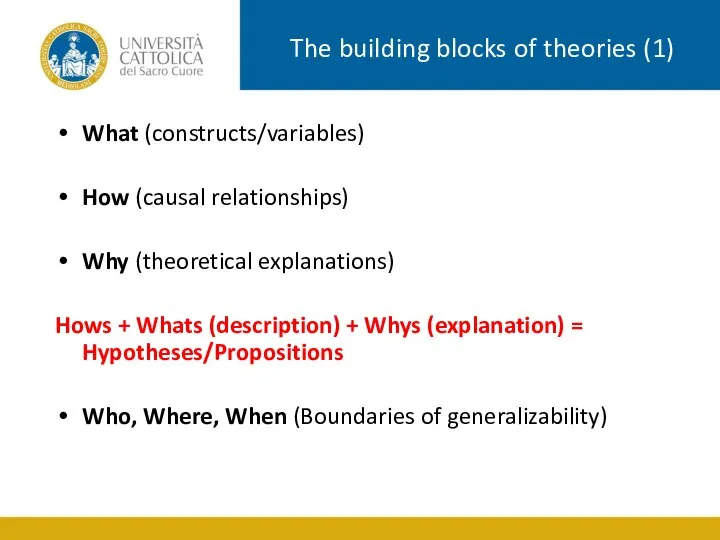
Who, Where, When (Boundaries of generalizability)
Слайд 3The building blocks of theories (2)
Construct (or concept): an abstract, unobservable property
The building blocks of theories (2)
Construct (or concept): an abstract, unobservable property

Proposition: a relationship linking constructs (e.g. “the strategy of an organization reflects the goals of its leader”)
Variable: a particular type of construct: a classification into two or more mutually exclusive and totally inclusive categories which explicitly vary by degree; it can be tied directly to empirical measures (e.g. identification, reputation, brand loyalty, self-esteem, diversification, centralization, etc.)
Hypothesis: a relationship linking variables, stated in a testable form (e.g. “the higher the size of a firm, the higher its financial performance”)
Measure/Indicator: property or relation whose presence or absence in a given case can be ascertained by direct observation
Слайд 4TURBAN ET AL. PAPER
TURBAN ET AL. PAPER
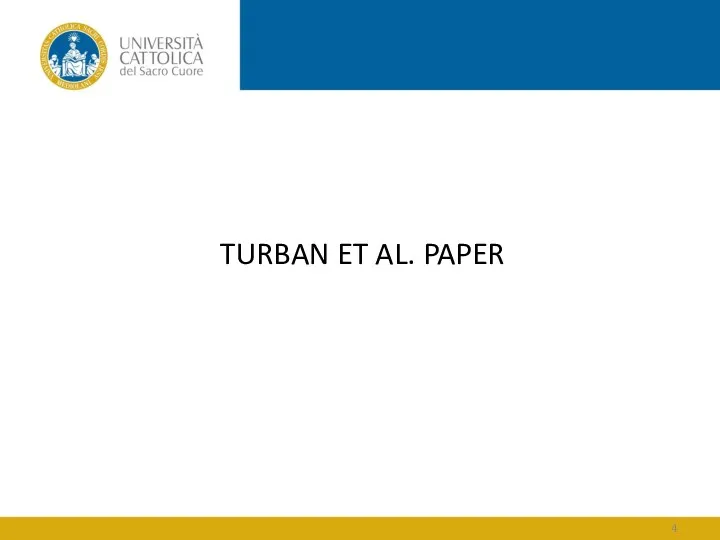
Слайд 5Many scholars and practitioners today are paying increasing attention to firms' corporate
Many scholars and practitioners today are paying increasing attention to firms' corporate
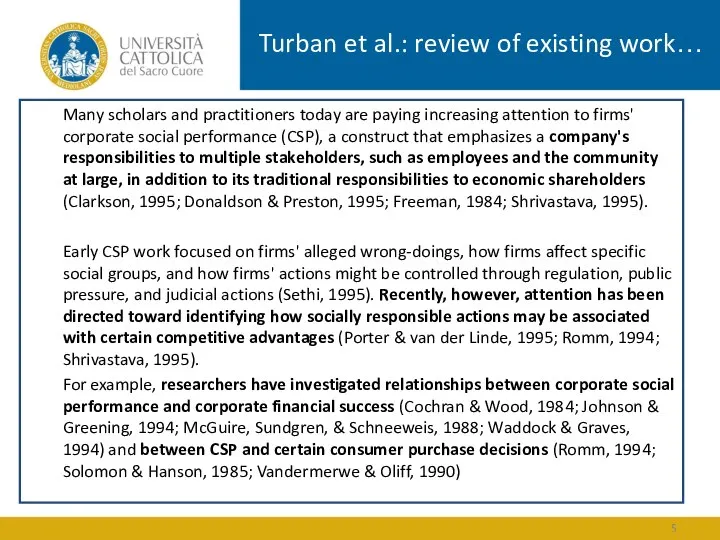
Early CSP work focused on firms' alleged wrong-doings, how firms affect specific social groups, and how firms' actions might be controlled through regulation, public pressure, and judicial actions (Sethi, 1995). Recently, however, attention has been directed toward identifying how socially responsible actions may be associated with certain competitive advantages (Porter & van der Linde, 1995; Romm, 1994; Shrivastava, 1995).
For example, researchers have investigated relationships between corporate social performance and corporate financial success (Cochran & Wood, 1984; Johnson & Greening, 1994; McGuire, Sundgren, & Schneeweis, 1988; Waddock & Graves, 1994) and between CSP and certain consumer purchase decisions (Romm, 1994; Solomon & Hanson, 1985; Vandermerwe & Oliff, 1990)
Turban et al.: review of existing work…
Слайд 6Attracting and retaining superior human resources can provide organizations with a sustained
Attracting and retaining superior human resources can provide organizations with a sustained
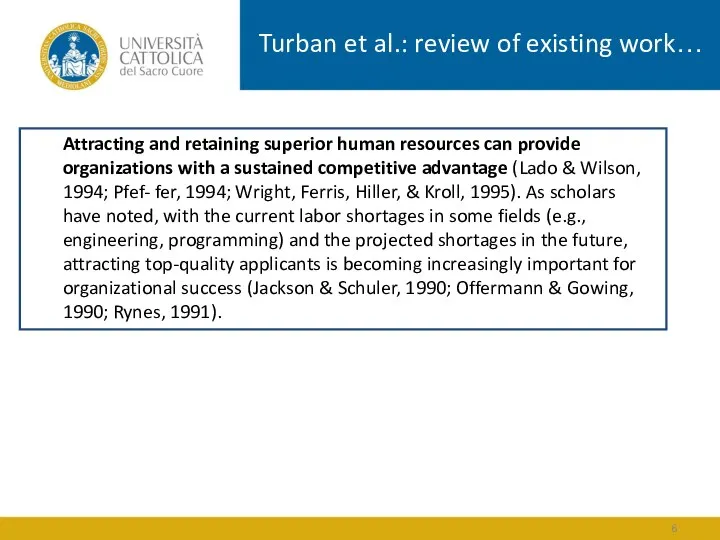
Turban et al.: review of existing work…
Слайд 7Turban et al.: knowledge gap…
Additionally, scholars have suggested that firms adopting socially
Turban et al.: knowledge gap…
Additionally, scholars have suggested that firms adopting socially
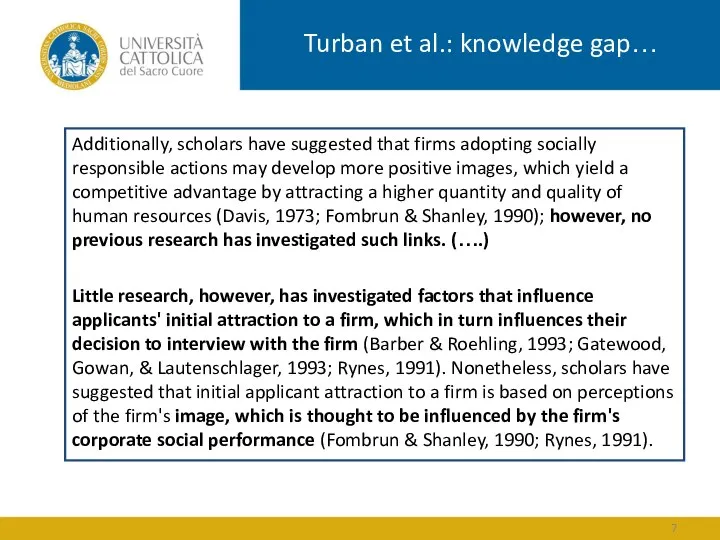
Little research, however, has investigated factors that influence applicants' initial attraction to a firm, which in turn influences their decision to interview with the firm (Barber & Roehling, 1993; Gatewood, Gowan, & Lautenschlager, 1993; Rynes, 1991). Nonetheless, scholars have suggested that initial applicant attraction to a firm is based on perceptions of the firm's image, which is thought to be influenced by the firm's corporate social performance (Fombrun & Shanley, 1990; Rynes, 1991).
Слайд 8Turban et al.: hypotheses to fill the gap
Hypothesis 1. Organizations higher on
Turban et al.: hypotheses to fill the gap
Hypothesis 1. Organizations higher on

Weaknesses of this hypothesis?
Was this your first idea for the research model?
Слайд 9Propositions based on signaling theory suggest that organizational attributes provide applicants with
Propositions based on signaling theory suggest that organizational attributes provide applicants with
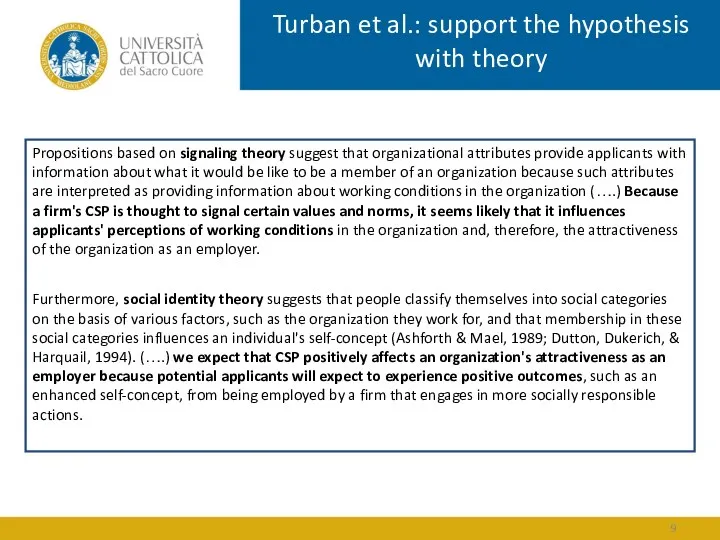
Furthermore, social identity theory suggests that people classify themselves into social categories on the basis of various factors, such as the organization they work for, and that membership in these social categories influences an individual's self-concept (Ashforth & Mael, 1989; Dutton, Dukerich, & Harquail, 1994). (….) we expect that CSP positively affects an organization's attractiveness as an employer because potential applicants will expect to experience positive outcomes, such as an enhanced self-concept, from being employed by a firm that engages in more socially responsible actions.
Turban et al.: support the hypothesis with theory
Слайд 10Process
The unit of analysis for this study was the organization, and we
Process
The unit of analysis for this study was the organization, and we
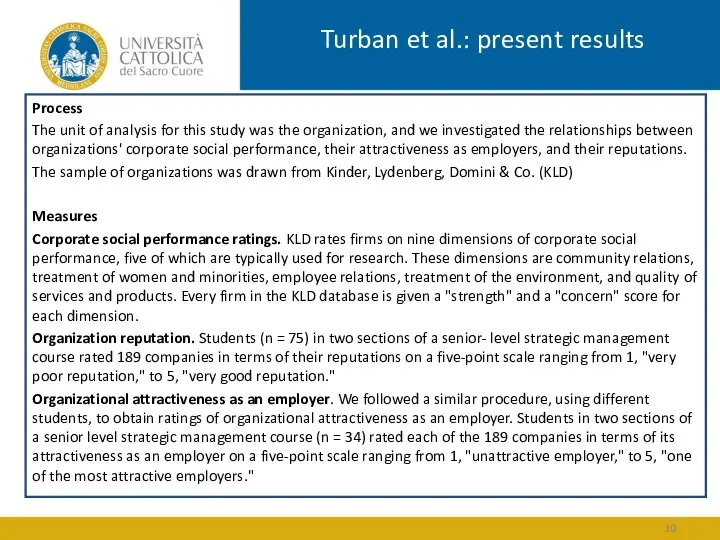
The sample of organizations was drawn from Kinder, Lydenberg, Domini & Co. (KLD)
Measures
Corporate social performance ratings. KLD rates firms on nine dimensions of corporate social performance, five of which are typically used for research. These dimensions are community relations, treatment of women and minorities, employee relations, treatment of the environment, and quality of services and products. Every firm in the KLD database is given a "strength" and a "concern" score for each dimension.
Organization reputation. Students (n = 75) in two sections of a senior- level strategic management course rated 189 companies in terms of their reputations on a five-point scale ranging from 1, "very poor reputation," to 5, "very good reputation."
Organizational attractiveness as an employer. We followed a similar procedure, using different students, to obtain ratings of organizational attractiveness as an employer. Students in two sections of a senior level strategic management course (n = 34) rated each of the 189 companies in terms of its attractiveness as an employer on a five-point scale ranging from 1, "unattractive employer," to 5, "one of the most attractive employers."
Turban et al.: present results
Слайд 11Turban et al.: present results
What do you think about this results?
What do
Turban et al.: present results
What do you think about this results?
What do

Слайд 12Turban et al.: mention limitations and call for future research
…Some of the
Turban et al.: mention limitations and call for future research
…Some of the

….. More broadly, research is needed to further explicate the causal relationships among corporate social performance, reputation, and attractiveness as an employer….REALLY???
….additional research is needed to investigate the causal mechanisms linking these variables. Additionally, research might further extend social identity theory by investigating whether individuals who work for firms with posi- tive CSP report higher levels of organizational identification (Mael & Tetrick, 1992) than individuals working for firms with negative CSP…
Слайд 13The relative position of variables
in a theory
Prior variable
Independent variable (antecedent)
Intervening (mediator)
Dependent
The relative position of variables
in a theory
Prior variable
Independent variable (antecedent)
Intervening (mediator)
Dependent

Consequent
Moderating variable
Слайд 14Conditions for causal inference (Campbell & Stanley, 1963)
The discovery of a statistical
Conditions for causal inference (Campbell & Stanley, 1963)
The discovery of a statistical
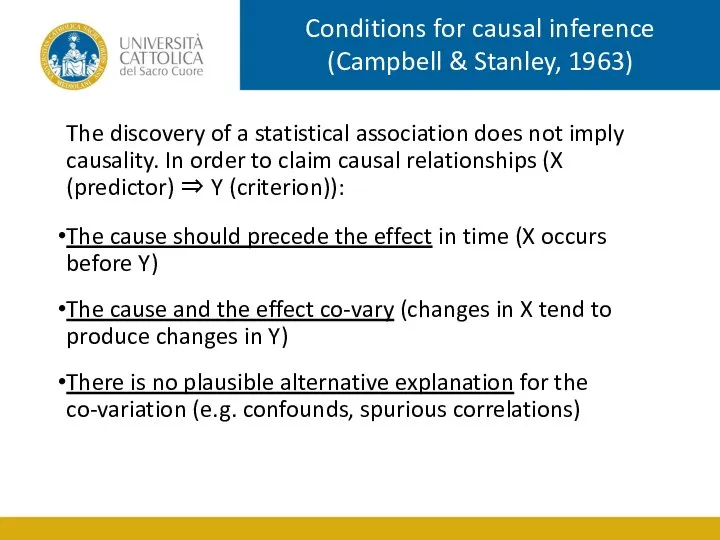
The cause should precede the effect in time (X occurs before Y)
The cause and the effect co-vary (changes in X tend to produce changes in Y)
There is no plausible alternative explanation for the co-variation (e.g. confounds, spurious correlations)
Слайд 15When is causality impossible? (Davis, 1985)
Y cannot cause X if…
Y starts (scores
When is causality impossible? (Davis, 1985)
Y cannot cause X if…
Y starts (scores
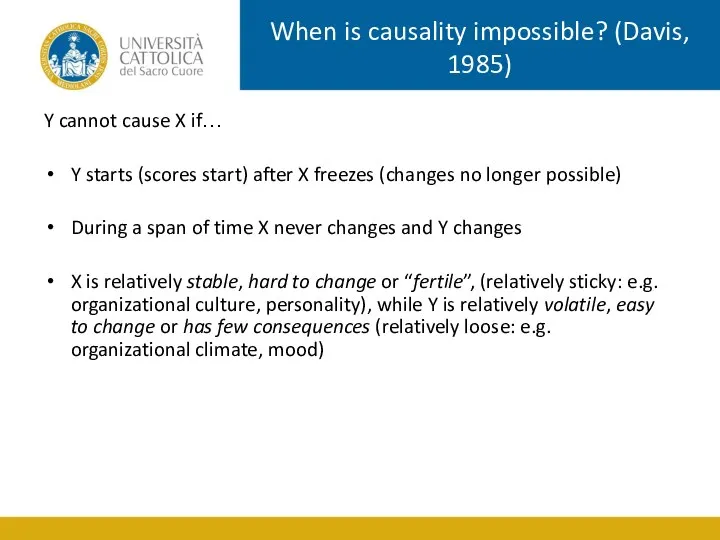
During a span of time X never changes and Y changes
X is relatively stable, hard to change or “fertile”, (relatively sticky: e.g. organizational culture, personality), while Y is relatively volatile, easy to change or has few consequences (relatively loose: e.g. organizational climate, mood)
Слайд 16Spurious and intervening relationships
Statistical association does not necessarily imply that variables are
Spurious and intervening relationships
Statistical association does not necessarily imply that variables are
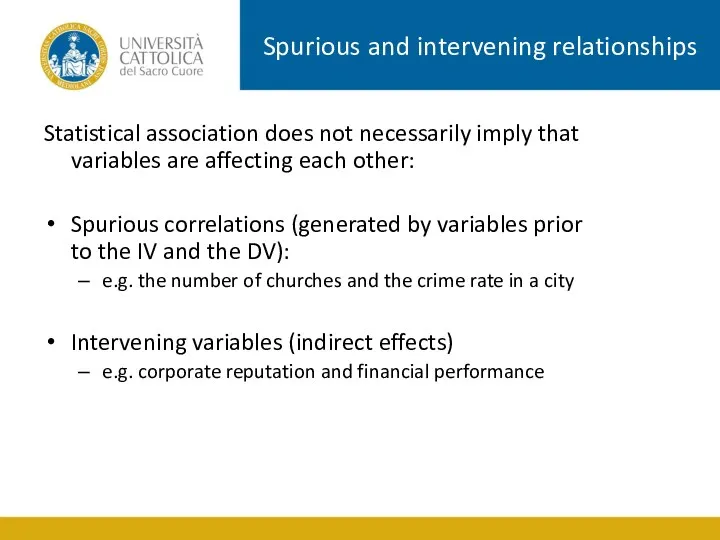
Spurious correlations (generated by variables prior to the IV and the DV):
e.g. the number of churches and the crime rate in a city
Intervening variables (indirect effects)
e.g. corporate reputation and financial performance
Слайд 17Endogeneity (+ sample selection bias + common method bias)
Reverse causality
Theory first!
Lagged data
Panel
Endogeneity (+ sample selection bias + common method bias)
Reverse causality
Theory first!
Lagged data
Panel
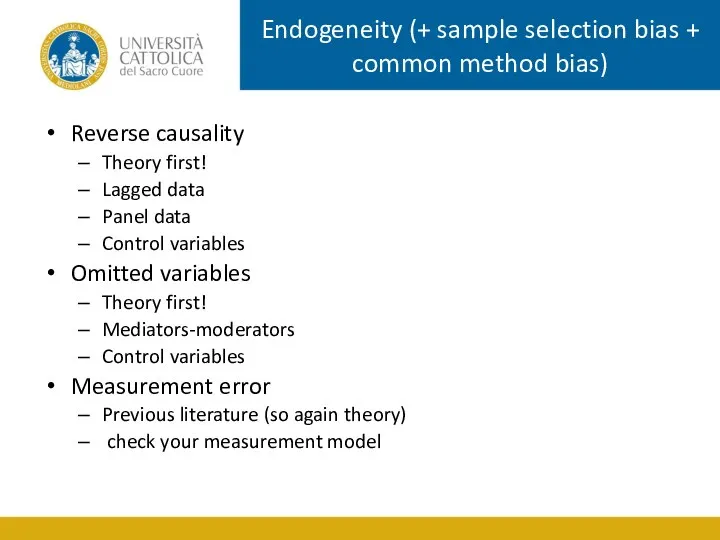
Control variables
Omitted variables
Theory first!
Mediators-moderators
Control variables
Measurement error
Previous literature (so again theory)
check your measurement model
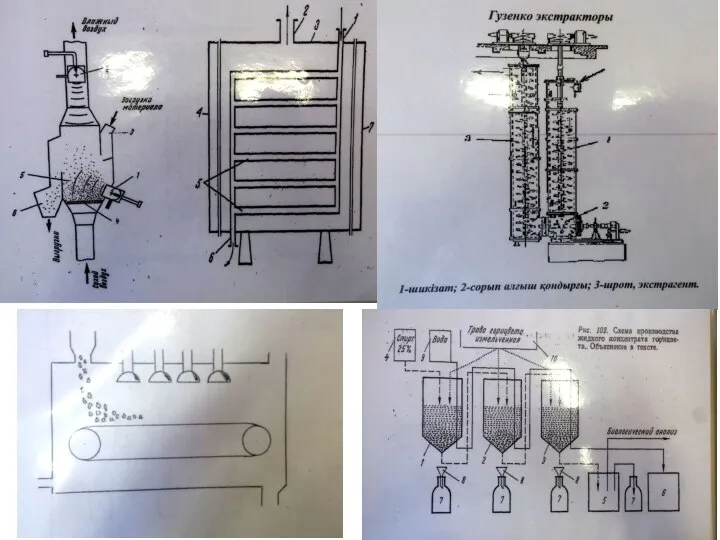 Эстракторы. Схемы
Эстракторы. Схемы Задача о железнодорожных составах
Задача о железнодорожных составах Закон Ома. Сопротивление проводника. Решение задач
Закон Ома. Сопротивление проводника. Решение задач Физика твердого тела
Физика твердого тела Достижения современной физики в нашей жизни. Производные предлоги. Узкоспециальные термины. Глаголы
Достижения современной физики в нашей жизни. Производные предлоги. Узкоспециальные термины. Глаголы Электромагнитные колебания
Электромагнитные колебания Измерение относительной влажности воздуха
Измерение относительной влажности воздуха Презентация на тему Электричество и магнетизм
Презентация на тему Электричество и магнетизм  УСТРОЙСТВО Л.Л
УСТРОЙСТВО Л.Л Инструмент MATE
Инструмент MATE Вектор магнитной индукции. Линии магнитной индукции
Вектор магнитной индукции. Линии магнитной индукции Вещества. Науки о природе
Вещества. Науки о природе ProMet: innovative hammerless system for bucket protection
ProMet: innovative hammerless system for bucket protection Можно ли соединить детали без соединительных материалов?
Можно ли соединить детали без соединительных материалов? Разработка методических указаний и постановка лабораторных работ. Силовая электроника
Разработка методических указаний и постановка лабораторных работ. Силовая электроника Строение твердых тел, жидкостей и газов
Строение твердых тел, жидкостей и газов Презентация на тему Идеальный газ в МКТ
Презентация на тему Идеальный газ в МКТ  Взаимодействие тел. Масса тел
Взаимодействие тел. Масса тел Метод пространства состояний. Марковские процессы
Метод пространства состояний. Марковские процессы Изменения геофизических характеристик прискважинной зоны
Изменения геофизических характеристик прискважинной зоны Теория автоматического управления. Дифференцирующие звенья
Теория автоматического управления. Дифференцирующие звенья Дробилка безрешетная
Дробилка безрешетная Физический поезд в страну Давление. Урок – соревнование 7 класс
Физический поезд в страну Давление. Урок – соревнование 7 класс Давление твердых тел. 7 класс
Давление твердых тел. 7 класс Колебательный контур
Колебательный контур Учение физики, открывшие газовые законы
Учение физики, открывшие газовые законы Влияние деформации на структуру и фазовый состав высокомарганцевых сталей
Влияние деформации на структуру и фазовый состав высокомарганцевых сталей Презентация на тему Диффузия
Презентация на тему Диффузия